| 1 |
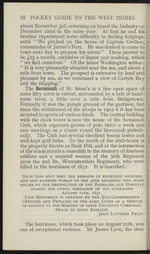 |
“...88 POCKET GUIDE TO THE WEST INDIES
Near this spot rest the remains of fourteen soldiers
AND ONE MARRIED WOMAN OF THE 36TH REGIMENT WHO WERE
KILLED BY THE DESTRUCTION OF THE BARRACKS AND HOSPITAL
DURING THE AWFUL VISITATION OF THE HURRICANE
August iith, 1831.
This Monument is erected by the Non-Commissioned
Officers and Privates of the same Corps as a tribute
OF RESPECT TO THE MEMORY OF THEIR DEPARTED COMRADES.
■ Peace to their Remains.
John Lowther Fecit.
The hurricane, which took place on August nth, was
one of exceptional violence. Sir James Lyon, the then
about November 3rd, returning on board the Industry on
December 22nd in the same year. At first he and his
brother experienced some difficulty in finding lodgings,
until “ We pitched on the house of Captain Crofton,
commander of James’s Fort. He was desired to come to
town next day to propose his terms.” These proved to
be £15 a month, exclusive of liquor and washing, which
“ we find ourselves.” Of the house Washington writes:
“ It...”
|
|
| 2 |
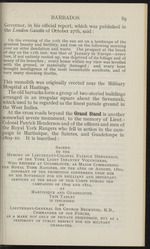 |
“...and rose on the following morning
I Ify'-f an ufr®r desolation and waste. The prospect at the break
bf day on the nth inst. was that of January in Europe—every
[free, if not entirely rooted up, was deprived of its foliage and of
Kmany of its branches ; every house within my view was levelled
[ with the ground, or materially damaged ; and every hour
[brought intelligence of the most lamentable accidents and of
[very many shocking deaths.
Phis monolith was originally erected near the Military
[Hospital at Hastings.
, The old barracks form a group of two-storied buildings
ferranged in an irregular square about the Savannah,
“which used to be regarded as the finest parade ground in
Ithe West Indies.
I At the cross roads beyond the Grand Stand is another
Isomewhat severe monument, to the memory of Lieut -
Colonel Patrick Henderson and of the officers and men of
the Royal York Rangers who fell in action in the cam-
Ipaign in Martinique, the Saintes, and Guadeloupe in
[1809-10. It is inscribed...”
|
|
| 3 |
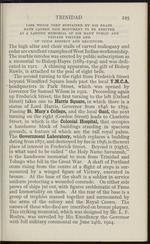 |
“...the right from Frederick Street
beyond Woodford Square leads past the local Y.M.C.A.
headquarters in Park Street, which was opened by
Governor Sir Samuel Wilson in 1922. Proceeding again
up Frederick Street, the first turning to the left (Oxford
Street) takes one to Harris Square, in which there is a
statue of Lord Harris, Governor from 1846 to 1854.
Passing St. Mary’s College, and the local Gaol, the next
turning on the right (Gordon Street) leads to Charlotte
Street, in which is the Colonial Hospital, that occupies
a handsome block of buildings standing in spacious
grounds, a feature of which are the tall royal palms.
The Government Laboratory, which replaces a building
dating from 1872, and destroyed by fire in 1896, is the next
place of interest in Frederick Street. Beyond it (right),
in what used to be called “ the Holy Name Savannah,”
is the handsome memorial to men from Trinidad and
Tobago who fell in the Great War. A shaft of Portland
stone rising from the centre of a flight of steps...”
|
|
| 4 |
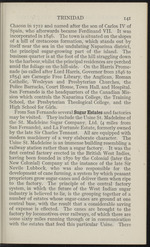 |
“...1 itself near the sea in the undulating Naparima district,
the principal sugar-growing part of the island. The
business quarter is at the foot of the hill straggling down
to the harbour,whilst the principal residences are perched
• amid the foliage on the hill-side. On the Harris Prome-
nade (so called after Lord Harris, Governor from 1846 to
t 1854) are Carnegie Free Library, the Anglican, Roman
Catholic, Wesleyan and Presbyterian Churches, -the
Police Barracks* Court House, Town Hall, and Hospital.
San Fernando is the headquarters of the Canadian Mis-
i sion which controls the Naparima College, the Training
: School, the Presbyterian Theological College, and the
High School for Girls.
From San Fernando several Sugar Estates and factories
may be visited. They include the Usine St. Madeleine of
the St. Madeleine Sugar Company, Ltd. (4 miles from
I San Fernando), and La Fortunée Estate, formerly owned
, by the late Sir Charles Tennant. All are equipped with
modem machinery of a very elaborate...”
|
|
| 5 |
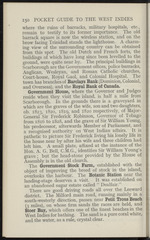 |
“...its former importance. The old
barrack square is now the wireless station, and on the
brow faring Trinidad stands the lighthouse. A charm-
ing view of the surrounding country can be obtained
from this spot. The old Dutch and French forts, the
buildings of which have long since been levelled to the
ground, were quite near by. The principal buildings in
Scarborough are the Government offices, police barracks,
Anglican, Wesleyan, and Roman Catholic churches,
Court-house, Royal Gaol, and Colonial Hospital. The
town has branches of Barclays Bank (Dominion, Colonial,
and Overseas), and the Royal Bank of Canada.
Government House, where the Governor and Judges
reside when they visit the island, is half a mile from
Scarborough. In the grounds there is a graveyard in
which are the graves of the wife, son and two daughters,
ob. 1823, 1820, 1819, and i820 respectively, of Major-
General Sir Frederick Robinson, Governor of Tobago
from 1816 to 1828, and the grave of Sir William Young,
his predecessor,...”
|
|
| 6 |
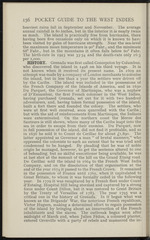 |
“...but no skilful executioner being available, he was
at last shot at the Summit of the hill on the Grand Etang road.
De Cerillac sold the island in 1664 to the French West India
Company, and on the dissolution of that organisation at the
end of the year 1674 it passed to the French Crown. It remained
in the possession of France until 1762, when it capitulated to
Great Britain, to whom it was formally ceded in the following
year. In 1779 it was recaptured by a French fleet under Count
d’Estaing, Hospital Hill being stormed and captured by a strong
force under Count Dillon, but it was restored to Great Britain
by the Treaty of Versailles of 1783. The year 1795 was a
critical one in the history of Grenada. In it began what was
known as the Brigands’ War, the notorious French republican,
Victor Hugues, making a determined effort to regain possession
of the island by bringing about an insurrection of the French
inhabitants and the slaves. The outbreak began soon after
midnight of March 2nd, when...”
|
|
| 7 |
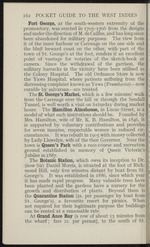 |
“...1705-1706 from the designs
and under the direction of M. deCaillus, and has long since
been abandoned for military purposes. The view from
it of the inner harbour or Carenage on the one side and
the bluff leeward coast on the other, with part of the
town of St. George’s at the foot, renders it an excellent
point of vantage for votaries of the sketch-book or
camera. Since the withdrawal of the garrison, the
military barracks in the vicinity have been utilised as
the Colony Hospital. The old Ordnance Store is now
the Yaws Hospital, where patients suffering from the
distressing complaint known as Yaws (Frambcesia)—now
curable by salvarsan—are treated.
The St. George’s Market, which is a few minutes’ walk
from the Carenage over the hill or through the Sendall
Tunnel, is well worth a visit on Saturday during market
hours. The Hamilton Almshouse, in Lucas Street, is a
model of what such institutions should be. Founded by
Mrs. Hamilton, wife of Mr. K. B. Hamilton, in 1846, it
is supported by voluntary...”
|
|
| 8 |
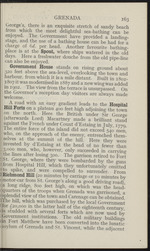 |
“...1887 and a new wingwas added
in 1902. The view from the terrace is unsurpassed. On
the Governor’s reception day visitors are always made
welcome. .
TT-««°üd with an easy gradient leads to the Hospital
1 Hill Forts on a plateau 400 feet high adjoining the town
ion the north. Here the British under Sir George
I (afterwards Lord) Macartney made a brilliant stand
I against the French under Count d’Estaing in July 1770.
I The entire force of the island did not exceed 540 men
I who, on the approach of the enemy, entrenched them-
I selves at the summit of the hill. Here they were
j mvested by d’Estaing at the head of no fewer than
13,000 men, who, however, only succeeded in carrying
Ithe lines after losing 300. The garrison retired to Fort
ISt. George, where thèy were bombarded by the guns
lfrom Hospital Hill, which they unfortunately omitted
(to spike, and were compelled to surrender. From
1 Richmond Hill (20 minutes by carriage or 10 minutes by
imotor-car from St. George’s along a good driving...”
|
|
| 9 |
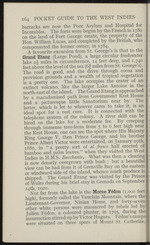 |
“...i64 POCKET GUIDE TO THE WEST INDIES
barracks are now the Poor Asylum and Hospital for
Incurables. The forts were begun by the French in 1780
on the land of Fort George estate, the property of the
Hon. William Lucas, and completed by the British, who
compensated the former owner, in 1784.
A favourite excursion from St. George's is that to the
Grand Etang (Large Pond), a large circular freshwater
lake miles in circumference, 14 feet deep, and 1,740
feet above the level of the sea (6J miles from St. George s).
The road is good, and the drive through cocoa and
provision grounds and a wealth of tropical vegetation
is a pretty one. The lake occupies the crater ^ of an
extinct volcano, like the larger Lake Antoine in the
north-east of the island. The Grand Etang is approached
by a macadamised path from Government Rest House
and a picturesque little Sanatorium near by. The
latter, which is let to whoever cares to take it, is an
ideal spot for a rest cure. It is connected with the
telephone system...”
|
|
| 10 |
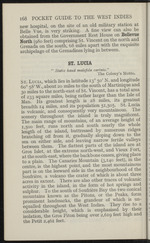 |
“...168 POCKET GUIDE TO THE WEST INDIES
new hospital, on the site of an old military station at
Belle Vue, is very striking. A fine view can also be
obtained from the Government Rest House on Bellevue
North (980 feet) comprising St. Vincent on the north and
Grenada on the south, 68 miles apart with the exquisite
archipelago of the Grenadines lying in between.
ST. LUCIA
" Statio hand malefida carinis."
The Colony’s Motto.
St. Lucia, which lies in latitude 130 50' N. and longitude
6o° 58' W., about 20 miles to the south of Martinique and
30 miles to the north-east of St. Vincent, has a total area
of 233 square miles, being rather larger than the Isle of
Man. Its greatest length is 28 miles, its greatest
breadth 14 miles, and its population 51,505. St. Lucia
is volcanic, and consequently very mountainous. The
scenery throughout the island is truly magnificent.
The main range of mountains, of an average height of
I 500 feet, runs north and south nearly the whole
length of the island, buttressed...”
|
|
| 11 |
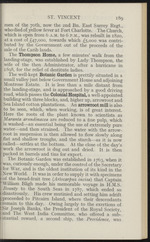 |
“...the proceeds of the
I sale of the Carib lands.
The Thompson Home, a few minutes’ walk from the
landing-stage, was established by Lady Thompson, the
[wife of the then Administrator, after a hurricane in
11898, for the relief of destitute ladies.
The well-kept Botanic Garden is prettily situated in a
I small valley just below Government House and adjoining
Montrose Estate. It is less than a mile distant from
the landing-stage, and is approached by a good driving
road, which passes the Colonial Hospital, a well-appointed
building with three blocks, and, higher up, arrowroot and
I Sea Island cotton plantations. An arrowroot mill is also
I to be seen, which, when working, is of great interest.
Here the roots of the plant known, to scientists as
[ Maranta arundinacea are reduced to a fine pulp, which
is washed—an essential being the use of extremely pure
water—and then strained. The water with the arrow-
root in suspension is then allowed to flow slowly along
flat and shallow troughs, and the...”
|
|
| 12 |
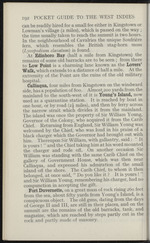 |
“... which is passed on the way ;
the time usually taken to reach the summit is two hours.
In the neighbourhood of Cavalries the unique Soufrière
fern, which resembles the British stag-horn moss
(Lycopodium clavatum) is found.
At Edinboro Bay (half a mile from Kingstown) the
remains of some old barracks are to be seen ; from there
to Low Point is a charming lane known as the Lovers’
Walk, which extends to a distance of half a mile. At the
extremity of the Point are the ruins of the old military
hospital.
Calliaqua, four miles from Kingstown on the windward
side, has a population of 800. Almost 200 yards from the
mainland to the south-west of it is Young’s Island, now
used as a quarantine station. It is reached by boat in
one hour, or by road (2^ miles), and then by ferry across
the narrow strait which divides it from the mainland.
The island was once the property of Sir William Young,
Governor of the Colony, who acquired it from the Carib
Chief. Returning from England, Sir William Young was...”
|
|
| 13 |
 |
“...capacity of 600,000 gallons.
Dorsetshire Hill was the scene of much fighting during
the wars with the French and the Caribs. The fortifica-
tions, which consisted only of earthworks, have long since
disappeared. To the north on Miller’s Ridge guns still
he dismounted on the ground.
An excellent school has recently been built on Dorset-
shire Hill to replace one destroyed by a hurricane some
years ago.
At Low Point, about 400 feet below the fort and to sea-
ward of the citadel, stands the military hospital, now
used for patients suffering from yaws (Frambcesia).
A ride to a high ridge called “ Vigie,” or “ Look-out,” ‘
about six miles in a north-easterly direction, is also worth
taking. This place was once a fortified post, and it is of
interest as having been the scene of several sharp engage-
ments between the English and French, with their Carib
allies, in the war of 1795-96. The different ridges are
concentrated into one elevation with three corneal hills I
where the Caribs fixed their camp...”
|
|
| 14 |
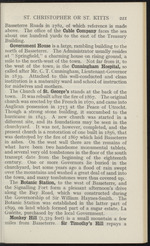 |
“...221
ST. CHRISTOPHER OR ST. KITTS
Basseterre Roads in 1782, of which reference is made
above. The office of the Cable Company faces the sea
about one hundred yards to the east of the Treasury
Building.
Government House is a large, rambling building to the
north of Basseterre. The Administrator usually resides
at " Springfield,” a charming house on rising ground, a
mile to the north-west of the town. Not far from it, to
the west of the town, is the Cunningham Hospital, so
called after Mr. C. T. Cunningham, Lieutenant-Governor
in 1839. Attached to this well-conducted and clean
institution is a maternity ward and school of instruction
for midwives and mothers.
The Church of St. George’s stands at the back of the
town. It was rebuilt after the fire of 1867. The original
church was erected by the French in 1670, and came into
Anglican possession in 1713 at the Peace of Utrecht.
Though a strong stone building, it succumbed to the
hurricane in 1843. A new church was started in a
different site...”
|
|
| 15 |
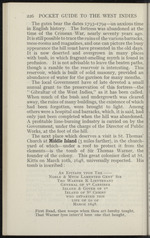 |
“...paths,
though a ramble to the reservoir is interesting. This
reservoir, which is built of solid masonry, provided an
abundance of water for the garrison for many months.
The local Government have of late devoted a small
annual grant to the preservation of this fortress—the
“ Gibraltar of the West Indies,” as it has been called.
When much of the bush and undergrowth was cleared
away, the ruins of many buildings, the existence of which
had been forgotten, were brought to light. Among
others were a hospital and barracks, which, it is said, had
only just been completed when the hill was abandoned.
A profitable lime-burning industry is carried on by the
Government, under the charge of the Director of Public
Works, at the foot of the hill.
The next place which deserves a visit is St. Thomas’
Church at Middle Island (3 miles farther), in the church-
yard of which—under a roof to protect it from the
elements—is the tomb of Sir Thomas Warner, the
founder of the colony. This great coloniser died at St...”
|
|
| 16 |
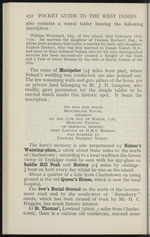 |
“...Captain of H.M.S. Boreas,
WAS MARRIED TO
Frances Herbert Nisbet.
The hero’s memory is also perpetuated by Nelson’s
Watering-place, a creek about three miles to the north
of Charlestown ; according to a local tradition the future
victor of Trafalgar could be seen with his spy-glass on
Saddle Hill Peak and Battery miles by carriage;
i hour on foot) every day whilst he was on the island.
About a quarter of a mile from Charlestown on rising
ground is the old Queen’s House, which is now the local
hospital.
The Jew’s Burial Ground on the north of the Govern-
ment road and to the south-west of “ Ramsbury ”
estate, which has been cleared of bush by Mr. H. C.
Huggins, has much historic interest.
At St. Thomas’, Lowland (about 3 miles from Charles-
town), there is a curious old tombstone, rescued some...”
|
|
| 17 |
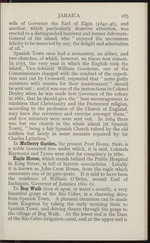 |
“...England,
may have due reverence and exercise amongst them,”
and five ministers were soon sent out. In 1664 there
was but one church in the whole island (at Spanish
Town), “ being a fair Spanish Church ruined by the old
soldiers but lately in some .measure repaired by Sir
Charles Lyttelton.”
In Mulberry Garden, the present Poor House, there is
a noble tamarind tree under which, it is said, Colonels
Raymond and Tyson were shot for conspiracy in 1660.
Eagle House, which stands behind the Public Hospital
in King Street, is full of historic associations. Locally
it is known as John Crow House, from the eagle which
surmounts one of its gate-posts. It is said to have been
the residence of William O’Brien, second Earl of
Inchiquin, Governor of Jamaica 1660-61.
To Bog Walk (boca de agua, or water’s mouth), a very
beautiful gorge of the Rio Cobre, is a charming drive
from Spanish Town. A pleasant excursion can be made
from Kingston by taking the early morning train to
Spanish Town, and driving thence...”
|
|
| 18 |
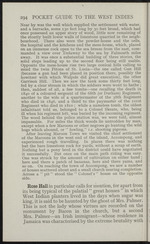 |
“...294 POCKET GUIDE TO THE WEST INDIES
Near by was the well which supplied the settlement with water,
and a barracks, some 130 feet long by 30 feet broad, which had
once possessed an upper story of wood, little now remaining of
the stoutly built lower walls of limestone quarried in the neigh-
bourhood. There also were the powder-house and the cells,
the hospital and the kitchens and the mess-house, which, placed
on an immense rock open to the sea breeze from the east, com-
manded a view over Trelawny to the sea by Falmouth miles
away. It was once a substantial building of three stories, the
solid steps leading up to the second floor being still usable.
Opposite the mess-house rise two large conical hills calling to
mind the twin Pitons of St. Lucia—the one called Gun Hill
(because a gun had been placed in position there, possibly the
howitzer with which Walpole did great execution), the other
Garrison Hill. Then we saw the tank some thirty feet long,
fed by a clear stream in which the soldiers...”
|
|
| 19 |
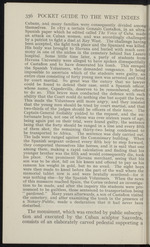 |
“...WEST INDIES :
Cubans, and many families were consequently divided among
themselves. In 1871 a certain Gonzalo Castaflon, in an ultra-
Spanish paper which he edited called The Voice of Cuba, mad»
an attack on Cuban women, and was accordingly challenged
by a patriot to fight a duel at Key West. The challenge having
beenaccepted, the fight took place and the Spaniard was killed*5
His body was brought to Havana and buried with much cere-
mony m one of the niches in the cemetery behind San Lazaro
hospital. Some little time later, a party of students from
Havana University were alleged to have spoken disrespectfully
of Castaflon and to have desecrated his tomb. This enraged
the Spanish Volunteers, who demanded vengeance. It being
impossible to ascertain which of the students were guilty an
entire class consisting of forty young men was arrested and tried
by court martial. So great was the outcry that no lawyer
could be found to defend their case, until a Spanish officer
whose name, Capedevilla...”
|
|
| 20 |
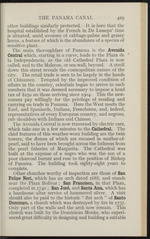 |
“...THE PANAMA CANAL
429
other buildings similarly protected. It is here that the
hospital established by the French in De Lesseps’ time
is situated, amid avenues of cabbage-palms and grassy
lawns, a feature of which is the abundance of a species of
sensitive plant.
The main thoroughfare of Panama is the Avenida
Central which, starting in a curve, leads to the Plaza de
la Independencia, as the old Cathedral Plaza is now
called, and to the Malecon, or sea-wall, beyond. A stroll
down this street reveals the cosmopolitan nature of the
city. The retail trade is seen to be largely in the hands
of Chinamen. Tempted by the improved condition of
affairs in the country, celestials began to arrive in such
numbers that it was deemed necessary to impose a head
tax of $250 on those arriving since 1904. This the new-
comers pay willingly for the privilege of residing and
carrying on trade in Panama. Here the West meets the
East, and Spaniards, Italians, Frenchmen, and, indeed,
representatives of every European...”
|
|
